| Quick Links |
|
|
|
|
|
|
Testimonials |
|
|
 |
| Of the hundreds of managers I've worked with in my career, Tom has to rank in the top 1%. He has everything you could want in a manager, a consultant, or a person. |
|
 |
|
|
|
|
2011
Growth Strategy Survey Results |
|
In
October of 2011, Don Springer (The
Colton Group) and I conducted
a survey of leaders from
22 companies
about their strategies. The
industries ranged from high
technology manufacturing to pure service companies. The goal of
the survey was to uncover the
strategy challenges for 2011.
The survey consisted of 12
questions.
1. What is your position
at your company?
2. What does your company
sell?
3. What industry do you
compete in?
4. What is the size of
your company (annual revenues)?
5. What is the size of
your company (employees)?
6. Is your company public
or private?
7. How often do you review
and revise your strategies?
8. How important are the
following to your business in
2011?
9. How do you currently
get better at strategy?
10. Rank the following areas in
order of needed improvement.
11. How do you measure the
effectiveness of your strategies
and use the results to improve?
12. How important is improving
your strategy process and
performance?
The survey can be
downloaded
here.
|
|
|
|
The survey respondents
overwhelming represented smaller
(<$50M in annual revenue)
private companies. Ninety
percent sold services (only 9%
sold only products).
Approximately 60% had 50 or
fewer employees.
Traditionally, this type of
company has fewer specialists as
compared to larger companies.
The leaders are often
responsible for strategy,
operations and day-to-day
management. Commonly,
significant roles that require
new skills are neglected or
minimized. |
|
|
 |
|
|
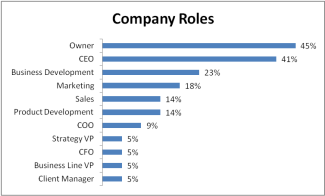
|
Notes:
The respondents largely
represent the people
that run the companies.
Although multiple titles
are possible for an
individual, slightly
less than half were
either the CEO or owner.
|
Top 5 Important Strategy
Activities in 2011
|
1.
Deciding
the right
strategy for the
business
|
|
2.
Aligning
the management
team to support
the strategy
|
|
3.
Balancing
strategy and
tactics
effectively
|
|
4.
Deploying
strategy within
the company
|
|
5.
Improving
operational
efficiency
|
|
Notes:
There are may options
for growth but deciding
on the right one for a
business is the
fundamental challenge
for most companies.
Selecting the right
strategy by testing
assumptions, leveraging
core strengths and
analyzing the
competitive environment
is difficult.
Interestingly, the
second step of aligning
the management team and
employees is the second
most pressing issue for
respondents. Clearly, an
effective strategy
requires thoughtful
deployment to succeed.
|
|
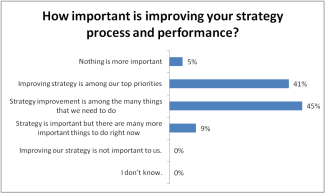
|
Notes:
No respondent thought
that strategy
improvement was
unimportant. Most
recognize that strategy
improvement competes
with other activities
for management
attention. The central
question is whether
there is a proper
balance between strategy
and tactics, between the
long term and the short
term. Only the
CEO/Owners can enforce
the right balance. |
|
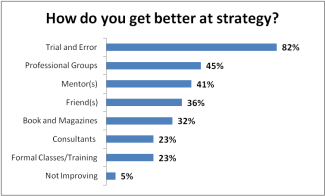
|
Notes:
Perhaps this is the most
profound feedback in the
survey. Though most
respondents feel the
need to improve
strategy, 4 out of 5
simply use
trial-and-error
techniques. This is
consistent with other
data that shows that
CEO/Owners value
intuition and experience
over other proven
methods. When strategy
is not already a core
strength of the
management team, this is
inefficient at best and
dangerous at worst. |
|
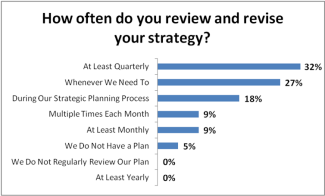
|
Notes:
Generally speaking,
strategy should not
change frequently since
that would imply
significant rippling
changes throughout the
organization too often.
On the other hand, SMB's
often seem to have few
mechanisms in place to
trigger reviews and
revisions, especially
when the key success
measures are the
trailing indicators of
revenue and profit (see
below). |
|
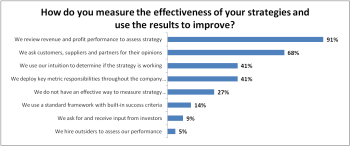
|
Notes:
The most common measures
of success are revenue
and profit performance.
While these are
undeniably important,
significantly, they are
trailing indicators of
successful strategy.
Proactive, leading
indicators are not
commonly used by the
respondents. |
|
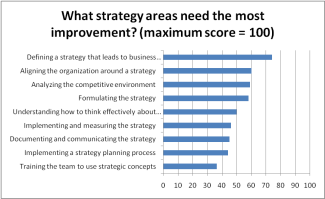
|
Notes:
The most common
challenge is defining a
strategy for business
growth in 2011. There
multiple reasons why
this might be so. First,
growth is fundamentally
difficult in a highly
competitive environment.
Second, few SMB leaders
use a methodical process
for finding growth
opportunities. Third, as
evidenced by the
challenges of
organizational
alignment, it is not
always easy to mobilize
the management team to
execute the strategy. |
|
|
|
|
|
|
|
|
|

